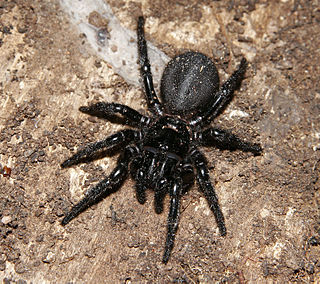
Ant spiders are members of the family Zodariidae. They are small to medium-sized eight-eyed spiders found in all tropical and subtropical regions of South America, Africa, Madagascar, Australia-New Guinea, New Zealand, Arabia and the Indian subcontinent. Most species are daytime hunters and live together with ants, mimicking their behavior and sometimes even their chemical traits. Although little is known about most zodariids, members of the genus Zodarion apparently feed only on ants; a number of other genera in the family are apparently also ant specialists.

Myrmarachne is a genus of ant-mimicking jumping spiders that was first described by W. S. MacLeay in 1839. They are commonly called antmimicking spiders, but they are not the only spiders that have this attribute. The name is a combination of Ancient Greek μύρμηξ, meaning "ant", and ἀράχνη, meaning "spider".

Hadronyche is a genus of venomous Australian funnel-web spiders that was first described by L. Koch in 1873. Originally placed with the curtain web spiders, it was moved to the Hexathelidae in 1980, then to the Atracidae in 2018.
Habronestes bradleyi is a spider species of the family Zodariidae.

Holoplatys is a genus of the spider family Salticidae.

Jotus is a spider genus of the family Salticidae, native to Australia, New Zealand, and Indonesia. There are thought to be many as yet undescribed species in southern Australia.

Maratus is a spider genus of the family Salticidae. These spiders are commonly referred to as peacock spiders due to the males' colorful and usually iridescent patterns on the upper surface of the abdomen often enhanced with lateral flaps or bristles, which they display during courtship. Females lack these bright colors, being cryptic in appearance. In at least one species, Maratus vespertilio, the expansion of the flaps also occurs during ritualised contests between males. The male display and courtship dance are complex, involving visual and vibratory signals.

Lampona is a genus of South Pacific spiders in the family Lamponidae that was first described by Tamerlan Thorell in 1869. At least two species have a whitish tip to the abdomen and are known as "white-tailed spiders". Both hunt other spiders and have been introduced to New Zealand. The name is derived from the Middle English laumpe, meaning "light" or "fire".
Opopaea is a genus of goblin spiders of the family Oonopidae. The genus is one of the largest within the family, with 180 accepted species.

Tamopsis is a genus of tree trunk spiders that was first described by B. Baehr & M. Baehr in 1987. Like other members of the family, they may be called two-tailed spiders, referring to two elongated spinnerets. The name is derived from the genus Tama and the Ancient Greek ὄψις, meaning "resembling".
Molycria is a genus of Australian ground spiders that was first described by Eugène Louis Simon in 1887.
Wydundra is a genus of ground spiders that was first described by Norman I. Platnick & Barbara Baehr in 2006. Originally placed with the long-spinneret ground spiders, it was transferred to the ground spiders in 2018.

Tharrhalea is a genus of crab spiders first described in 1875 by Ludwig Carl Christian Koch.
Storena is a genus of ant spiders first described by Charles Athanase Walckenaer in 1805.
Hortophora is a genus of South Pacific orb-weaver spiders first described by V. W. Framenau, R. L. C. Baptista and F. S. M. Oliveira in 2021.








